Llamau |  Wales
Wales
Objectives
- Understand who benefits from Llamau’s services so that the organization can better support the young homeless and vulnerable populations they serve.
- Identify projects and locations that have the best outcomes, as well as those that need improving, and investigate contributing causes and factors.
- Evaluate the outcomes from each of Llamau’s services to gain insights to help improve the services they provide to individuals.
Findings
- Males using Llamau’s services, who have a history of youth offending and are care leavers, show lower levels of progression, even with Llamau’s support.
- There was a positive correlation between a young person’s engagement with a service and their outcomes, but nevertheless some projects had less positive outcomes despite how well engaged individuals were.
Question
As Wales’ leading homeless charity, Llamau works to support vulnerable individuals and support them in their path out of homelessness. They strive to help these individuals overcome traumas they may have experienced, become financially independent, economically active and achieve their goals and aspirations.
Llamau teamed up with DataKind UK and the Office for National Statistics (ONS), for a stat-filled, model-fueled weekend of diving into the data to find out:
- Of the people actively using Llamau’s services, which are benefiting the most from Llamau’s programs and why?
- Which services and projects are achieving the most successful outcomes for the individuals Llamau serves and why?
- What improvements should be made to Llamau’s existing Case Management System for collecting data?
What Happened
Llamau staff worked closely with DataKind UK and three Data Ambassadors – volunteer analysts from the ONS who led the project – to ready the data and refine the key questions to be addressed in a May 2017 DataDive. An additional forty volunteer data scientists joined the weekend event at the ONS offices in Newport, Wales and worked alongside the Data Ambassadors, DataKind UK’s team, partners from Llamau and the ONS, to meet the challenge and answer the questions that Llamau had set forth.
The DataDive volunteers uncovered many interesting learnings over the two days. One of the most significant, was the discovery of how greatly outcomes can differ for individuals in Llamau’s services. They looked at typical outcomes for different categories of service users and saw less positive outcomes for people who were a) male b) youth offenders, and/or c) previously in the care system. The team at Llamau had found anecdotally that this was the case, but the magnitude of difference was larger than expected. When an individual fitted into two or more of these categories at the same time, the likelihood of a successful outcome dropped even further.
There are a number of reasons that Llamau believes may explain these findings. One reason might be an underrepresentation of male staff within Llamau’s frontline teams; as young men may benefit from increased interaction with positive male role models. It’s also possible that these young men start at a different ‘baseline’ when compared with other beneficiaries. These young men may need longer periods of support and may progress more slowly than others. This may affect how Llamau measures and compares outcomes for different groups in the future.

The teams were also able to quantify the differences in user outcomes depending on various factors; namely, the type of service used, the person’s level of engagement, and the specific personal issues the individual faced. They found a positive correlation between the level of an individual’s engagement and their outcome. For instance, those that regularly attended sessions and services tended to make more progress and have better outcomes. Additionally, the team identified projects where people were not making substantial progress, despite their level of engagement. Llamau is planning to investigate this to find out what the underlying causes are and how to address them, for example, with internal interventions such as additional staff training, or taking into account external factors, e.g. the length of contracts awarded.

One exploratory piece of work done at the DataDive showed that 20 percent of the people who participated in a specific four week programme designed for people that were about to become homeless go on to be referred for further support. The volunteers created a neural network that could predict, with 85 percent accuracy, which of these service users would eventually return. This showed Llamau the power of using their data for predictive analytics and gave them a useful tool to discuss with commissioners.
Summary Findings:
Next Steps
Possibly the most important takeaway from the weekend was an awareness of what can be made possible with data – and what data is and isn’t useful. The atmosphere of discovery was infectious throughout the DataDive and the Llamau team was excited with the learnings and outcomes the event produced. Llamau’s Deputy CEO claimed that she went home following the DataDive and “dreamed about the data”.
Llamau is planning to launch a pilot for their new Case Management System in April 2018 – many of the insights gained from the DataDive on how they currently collect data will be fed into the design process. With their improved understanding of data – knowing what data they need and how the data can be used – Llamau can also now advise their funders on what data they should be collecting.
There is still a lot more untapped potential but DataKind and ONS helped Llamau to kick-start their journey toward that potential.
“We are not going to collect data we don’t need to collect. We feel that we can be more efficient, get more value, but we can also spend more vital time face-to-face with our users. We want data insights to inform our practice in the future and the DataDive was a huge step for our data maturity.” – Sue Gershenson, Llamau



